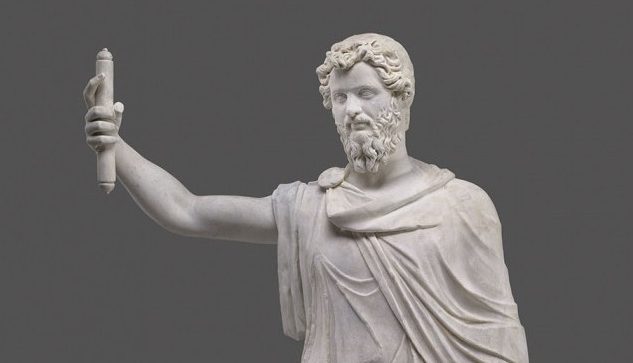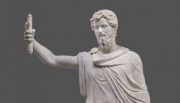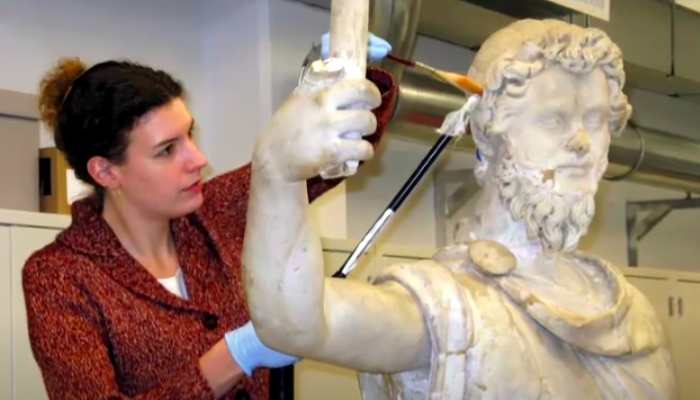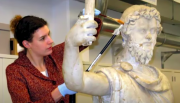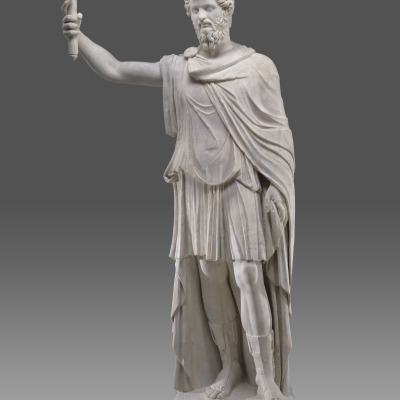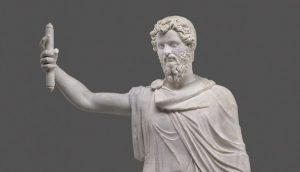
Septimius Severus
In 1967 the Virginia Museum of Fine Arts acquired a monumental statue of the Roman emperor Septimius Severus. Learn more about the statue, and the VMFA research and conservation effort.
Learn more about Septimius Severus and the VMFA statue.
Born of Roman and Punic stock around 145 in the city of Lepcis Magna in North Africa, Lucius Septimius Severus is sometimes referred to as the African Emperor. He served in both military and diplomatic posts, rising through the ranks until his soldiers proclaimed him emperor in 193, a year of tremendous upheaval in the Roman Empire. Following a period of civil war, Severus instituted military and administrative reforms that stabilized the empire, secured its frontiers, and replenished its treasury. Severus died in 211 in a part of Roman Britain that is now York, England. His two sons, Caracalla and Geta, succeeded him, and his descendants continued to rule the empire until the death of Alexander Severus in 235, bringing an end to the Severan dynasty.
Dozens of portraits of Septimius Severus have survived from antiquity—including works of bronze, marble, and gemstones—and thousands of coins bear his image. VMFA’s portrait has been called the “Marcus Aurelius–Severus type,” after the emperor Marcus Aurelius, who reigned from 161 to 180 and was extremely popular. Severus claimed, probably falsely, that Marcus Aurelius had adopted him. The use of this portrait type reinforced this propagandistic assertion, thereby granting Severus legitimacy by associating him with his much-loved and respected predecessor.
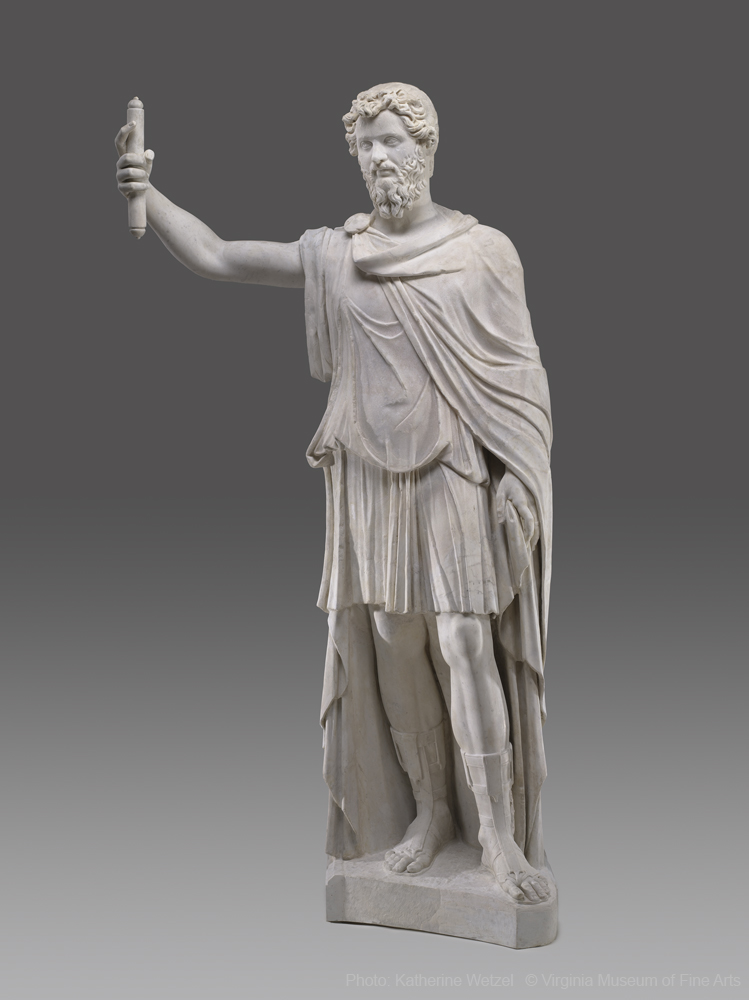
Septimius Severus
Roman, ca. 200 A.D.
Marble
The Adolph D. and Wilkins C. Williams Fund.
The Statue’s History
Vincenzo Giustiniani was one of the most famous and innovative aristocratic collectors of the 17th century. His collection included art of his own day and more than 1,500 pieces of ancient statuary. He delighted in dramatic displays of his collection that brought antiquity to life. As part of this effort, Giustiniani supervised an army of technicians who made extensive repairs to works by adding elements to ancient fragments to create complete statues. VMFA’s Septimius Severus is one such example.
This method of creatively completing ancient statues is very different from today’s efforts toward conservation and restoration, which seek to preserve the integrity of fragments. Giustiniani was nevertheless an important figure in the development of art history. His famous and much visited gallery was a precursor to the modern museum, and he produced one of the first illustrated catalogues of ancient sculpture—The Galleria Giustiniani—in which VMFA’s statue of Septimius Severus appears. Giustiniani also wrote a treatise on connoisseurship and the conservation of ancient sculpture.
In the early 1900s Mrs. Frederick F. Thompson, a wealthy and well-connected New York collector, brought a number of sculptures from the Giustiniani collection to the United States. Many of the statues had sustained damage during the voyage and were sent to the Metropolitan Museum of Art to be repaired and conserved. Eleven of the works remained at the Met and others were sent to institutions throughout the country. The Septimius Severus statue was part of the art collection at Williams College in Massachusetts until VMFA acquired it in 1967.
Art Historical Puzzle and Scientific Research
Art historians often date and authenticate works of art by looking at their style and iconography. In the case of Septimius Severus, there were disagreements among scholars as to whether the carving was consistent with Severan-era stonework and whether an emperor would have been portrayed in this style of clothing. While research indicated that both the head and torso could be ancient, it appeared they were not from the same statue. The unusual clothing led one scholar to speculate that the statue may depict Severus in eastern garb as a reference to his victories over the Parthians, who lived on the eastern edge of the Roman Empire. A second possibility was that the head and torso had both been carved in the 17th century, when the conventions of Roman imperial portraiture were just beginning to be seriously studied by people such as Giustiniani. A further possibility was that even if the head and torso were not from the same statue, either or both could still have been carved in antiquity.
To help sort out these questions, VMFA researchers consulted with scholars of ancient and early modern art as well as with other institutions with sculptures from the Giustiniani collection, including the Metropolitan Museum of Art, the Chrysler Museum of Art, and the J. Paul Getty Museum. They also undertook scientific analysis to determine the origin of the marble and to identify the materials used in previous restoration efforts. This information could show how the pieces of the statue were put together, allowing conservators to remove them safely and replace unstable repairs.
X-rays were taken to see what methods held the various parts of the sculpture together. Throughout its history, the sculpture had been repaired and reassembled using various marble pieces and supports. Researchers discovered that iron rods—typical of 17th-century practice—were inserted in some parts of the sculpture, and brass rods—generally used in the 20th century—were present in others. Additional materials had been used to fill in cracks between the sections. These materials were also analyzed to determine their composition. This information, along with the layered structure of the fills, provided a possible timeline that indicated when the parts may have been combined.
Researchers concluded that the head and torso were created in antiquity. But this didn’t tell them when the pieces were brought together—in antiquity or during the Renaissance?
In order to determine the origin of the marble, stable isotope ratio analysis was carried out on six different samples from the major fragments. Results of the analysis showed that the marble of the neck, arms, and lower legs was a type of Cararra marble that was used extensively in Italy and only available during the Renaissance. The marble of the head and torso came, respectively, from Mt. Pentilikon, near Athens, and the Aegean island of Paros. The most likely period for Pentelic and Parian marbles to be used in Rome is antiquity, when the city was the center of a thriving marble trade throughout the Mediterranean.
With this information, researchers concluded that the head and torso were created in antiquity. But this didn’t tell them when the pieces were brought together—in antiquity or during the Renaissance? Ancient statues were often made from several pieces of marble or combined different types of stone. Sometimes a block of marble proved too small for a patron’s—or artist’s— conception of the finished work. Some marbles were more prestigious than others; for instance, the head might be carved from a more expensive marble than the body. It was also common to carve the head and body separately, so that a customized portrait could be inserted into a standardized body. Typically, an added head had a tenon below the neck that fit into a hole between the shoulders. The physical evidence on this sculpture does not support this theory. Instead, it seems that the head and torso belonged to separate works of art that were damaged and later combined. At some point, perhaps in Giustiniani’s time, these two fragments were joined into a single piece, and then the lower part of the legs, the arms, most of the neck and lower face, and elements of the drapery and hair were added to create a complete, monumental statue of Septimius Severus.
The remaining questions pertained to the original contexts of the torso and head. The torso shows a male body wearing clothes similar to those shown in statues and reliefs produced from the mid-2nd century and into the 3rd century (around the time of Septimius Severus). Without the original arms, legs, or head, it is impossible to determine who was originally portrayed.
Conservation and Restoration
After research was completed, conservators and curators worked together to come up with a plan of action. They decided to restore the statue of Septimius Severus to its 17th-century appearance in order to celebrate that period’s unique combination of creativity and science.
First and foremost, the sculpture needed to be structurally stabilized. Though some of the older fills and repairs had deteriorated, conservators tried to keep the historically significant restoration material in place whenever possible. Joints and fills were reinforced with modern material, which is more durable yet easy to differentiate from the original under close examination. Second, the sculpture was heavily soiled and needed extensive cleaning.
In order to retain evidence of the 17th-century restoration, new materials were added by methods that allowed them to be removed or undone in the future. Old fills and adhesive material were preserved by applying a viscous solution of acrylic resin to form a barrier between the old and new materials. The more recent damage to the marble (from the early 20th century) was isolated in a similar manner, so that the 21st-century additions can be recognized as separate and removed, if necessary, by future conservators. The cracks in the marble were filled with a modified plaster and toned with dry pigments to match the color and texture of the marble. Calcium carbonate, also known as whiting (essentially powdered chalk), was added to decrease the cohesive strength of the plaster, and ultrafine fumed silica was used to enhance its modeling and handling characteristics. These newer fill materials were shaped and modeled by hand with a variety of spatulas and sculpture tools.
Once the losses were filled and toned, Septimius Severus was returned to its rightful place in the museum’s new galleries as a work that honors both its classical origins and the rediscovery of antiquity in the early modern period.
Septimius Severus Conservation
6:26In 1967 the Virginia Museum of Fine Arts acquired a monumental statue of the Roman emperor Septimius Severus. In 2007 the museum undertook a comprehensive research campaign using scientific and art historical methods to determine whether or not the statue is a work of ancient art.
